tow BUICK CENTURY 1993 Owners Manual
[x] Cancel search | Manufacturer: BUICK, Model Year: 1993, Model line: CENTURY, Model: BUICK CENTURY 1993Pages: 324, PDF Size: 17.58 MB
Page 19 of 324
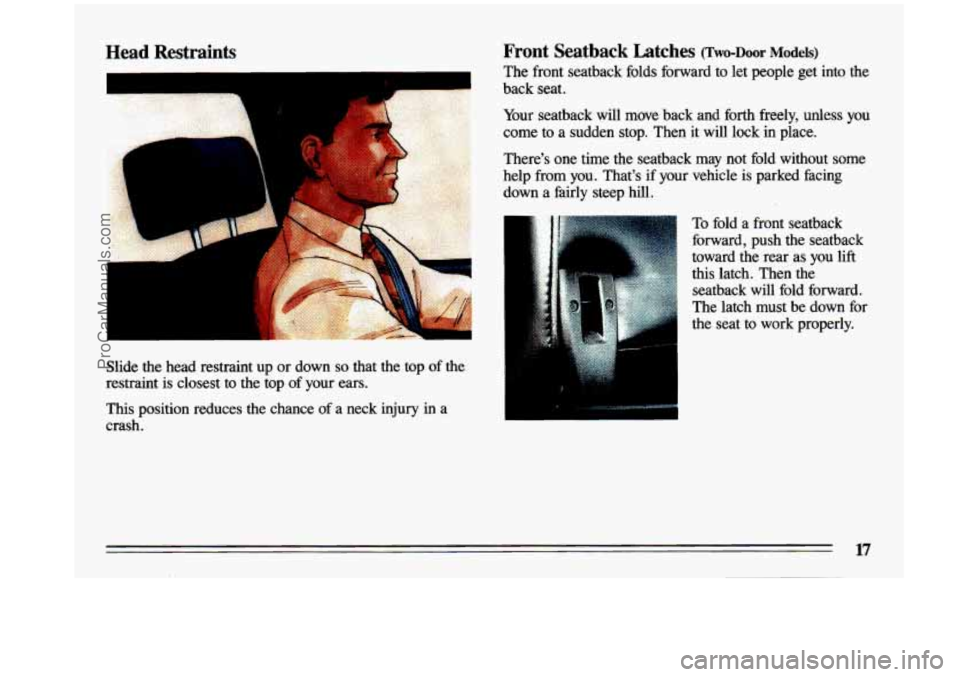
Head Restraints
Slide the head restraint up or down so that the top of the
restraint is closest to the top of your ears.
This position reduces the chance of a neck injury in a
crash.
Front Seatback Latches (Two-Door Models)
The front seatback folds forward to let people get into the
back seat.
Your seatback will move .back and forth freely, unless you
come to a sudden stop. Then it will lock in place.
There’s one time the seatback may not fold without some help from you. That’s if your vehicle is parked facing
down a fairly steep hill.
To fold a front seatback
forward, push the seatback
toward the rear as you
lift
this latch. Then the
seatback will fold forward.
The latch must be down for
the seat to work properly.
17
ProCarManuals.com
Page 24 of 324

-
i
2. Pull the seatback toward the rear of the vehicle, then
push it down into the locked position.
3. Lower the storage compartment lid.
22
ProCarManuals.com
Page 40 of 324
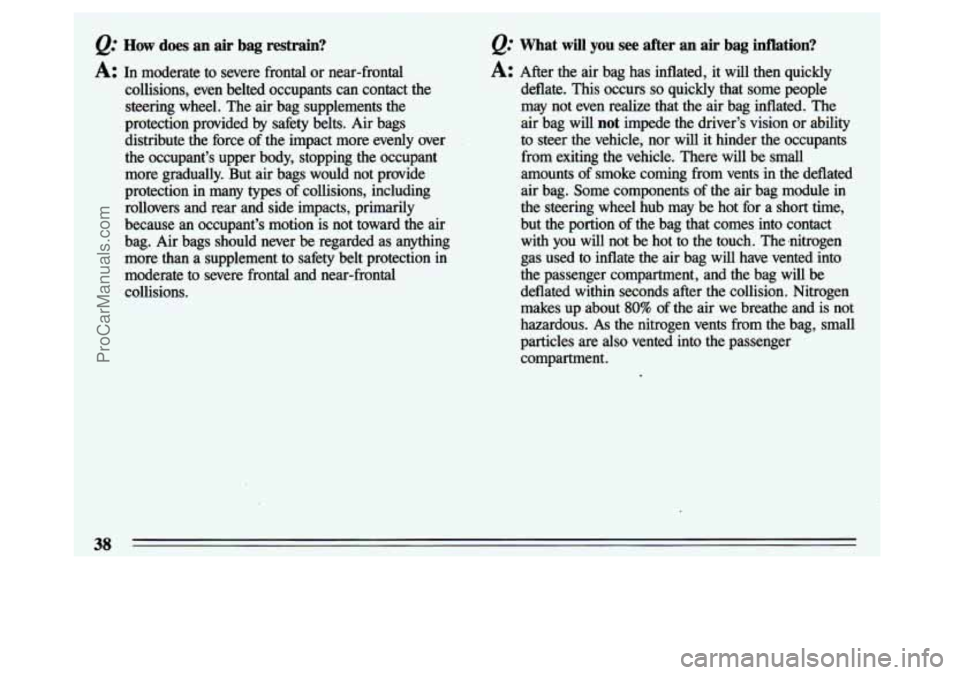
How does an air bag restrain?
A: In moderate to severe frontal or near-frontal
collisions, even belted occupants
can contact the
steering wheel. The air bag supplements the
protection provided by safety belts. Air bags
distribute the force of the impact more evenly over
the occupant’s upper body, stopping
the occupant
more gradually. But air bags would not provide
protection in many types
of collisions, including
rollovers and rear and side impacts, primarily
because an occupant’s motion is not toward the air
bag. Air bags should never be regarded as anything more than a supplement to safety belt protection in
moderate to severe frontal and near-frontal
collisions.
Qt What will you see after an air bag inflation?
A: After the air bag has inflated, it will then quickly
deflate.
This occurs so quickly that some people
may not even realize that the air bag inflated. The
air bag will
not impede the driver’s vision or ability
to steer the vehicle, nor will it hinder the occupants from exiting the vehicle. There will be
small
amounts of smoke coming from vents in the deflated
air bag. Some components of the air bag module in
the steering wheel hub may be hot
for a short time,
but the portion
of the bag that comes into contact
with you
will not be hot to the touch. The nitrogen
gas used to inflate the
air bag will have vented into
the passenger compartment, and the bag will be
deflated within seconds after the collision. Nitrogen
makes up about
80% of the air we breathe and is not
hazardous.
As the nitrogen vents from the bag, small
particles are also vented into the passenger compartment.
ProCarManuals.com
Page 61 of 324

1 CAUTION:
LJ
I
l!=r do this. I
Here two children are wearing the same belt. The belt can’t properly spread the
impact forces. In a crash, the two children
can be crushed together and seriously injured.
A belt must be used by only one
person at
a time.
@ What if a child is wearing a lap-shoulder belt, but
the child
is so small that the shoulder belt is very
close to the child’s face
or neck?
A: Move the child toward the center of the vehicle, but
be
sure that the shoulder belt still is on the child‘s
shoulder,
so that in a crash the child‘s upper body
would have the restraint that belts provide.
If the
child is
so smaU that the shoulder belt still is very
close to the child’s face or neck, you might want to
place the child
in the center seat position, the one
that has
only a lap belt.
ProCarManuals.com
Page 75 of 324
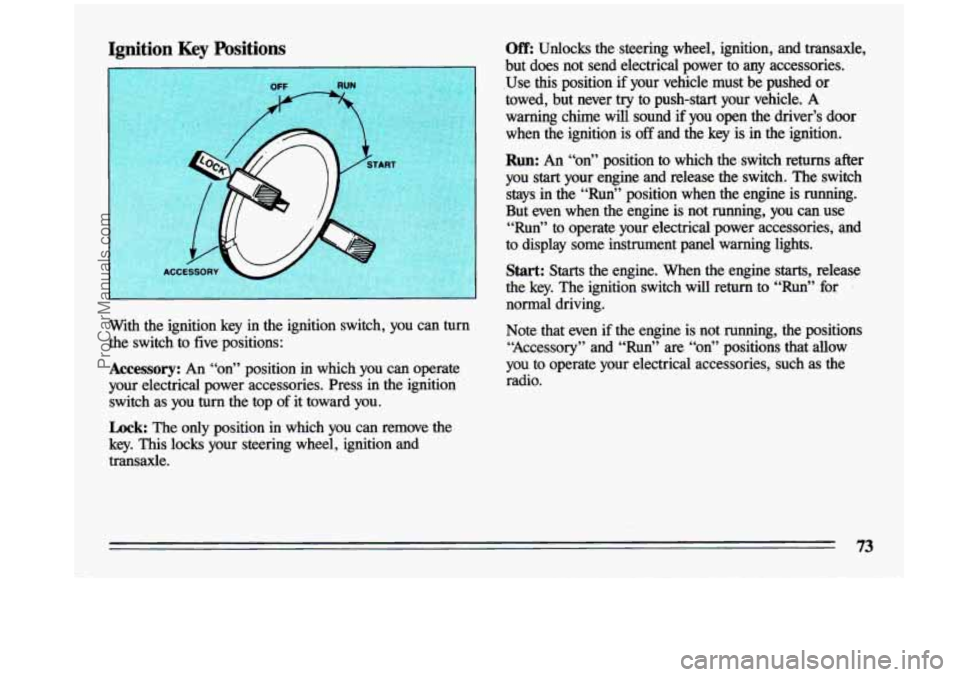
Ignition Key Positions Off: Unlocks the steering wheel, ignition, and transaxle,
but does not send electrical power to any accessories.
.Use
this position if your vehicle must be pushed or
towed, but never try to push-start your vehicle.
A
warning chime will sound if you open the driver’s door
when the ignition
is off and the key is in the ignition.
I
Run: An “on” position to which the. switch returns after
you
start your engine and release the switch. The switch
stays in the “Run” position when the engine is running.
But even when the engine is not running, you can use
“Run” to operate your electrical power accessories, and
to display some instrument panel warning lights.
Start: Starts the engine. When the engine starts, release
the key. The ignition switch will return to “Run” for
normal driving.
with the ignition key
h the ignition switch, YOU can turn Note that even if the engine is not running, the positions
the switch to five positions: “Accessory” and “Run” \
are “on” positions that allow
.Accessory: An “on” position in which you can operate you to operate your electrical accessories, such as the
your electrical power accessories. Press
in the ignition ‘ radio.
switch as you
turn the top of it toward you.
Lock: The only position in which you can remove the
key. This locks your steering wheel, ignition
and
transaxle.
ProCarManuals.com
Page 79 of 324

NOTICE:
After you’ve
How long should you keep the block heater plugged in? The
answer depends on the weather, the kind of
oil you have,
and some other things. Instead of trying
to list everything
here, we ask that you contact a Buick dealer, in the area
where you’ll be parking your vehicle. The dealer can give
you the best advice for that particular area.
Automatic .Transaxle
There are several different
positions for your
shift
lever.
P (Park)
This locks your front wheels. It’s the best position to use\
when you
start your engine because your vehicle can’t
move easily.
I- -
I a CAUTION:
It is dangerous to get out of your vehicle if the
shift lever is
not fully in “P” (Park) with the
parking brake firmly set.
Your vehicle can roll.
Don’t leave your vehicle when the engine is
running unless you have to. If you have left the
engine running, the vehicle can move
suddenly. You
or others could be injured. To I
be sure your vehicle won’t move, when you’re
on fairly level
ground, always set your parking
brake and move the shift lever to “P” (Park).
See “Shifting
Into ‘P’ (Park)” in the Index. If
you are parking
on a hill, or, if you’re pulling a
trailer, also see “Parking
on Hills” or “Towing
a Trailer”
in the Index.
R (Reverse)
Use this gear to back up.
ProCarManuals.com
Page 80 of 324
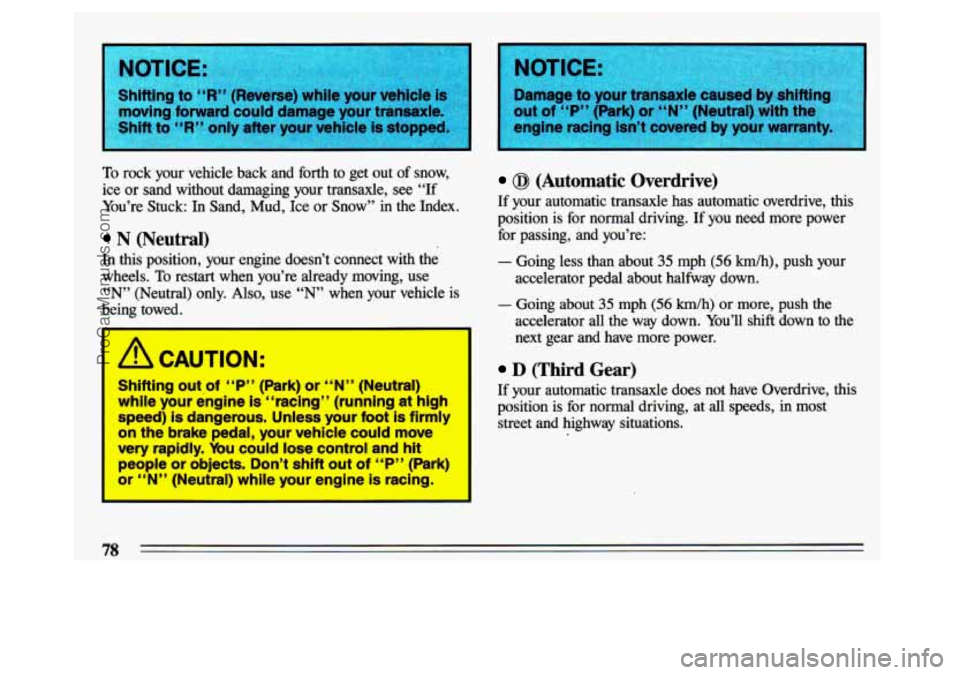
f, ‘,,moving forward could damage your transaxle,
to
“R” only after your vehicle is stopped
To rock your vehicle back and forth to get out of snow,
ice or sand without damaging your transaxle, see “If
You’re
Stuck: In Sand, Mud, Ice or Snow’’ in the Index.
N (Neutral)
In this position, your engine doesn’t connect with the
wheels.
To restart when you’re already moving, use
“N” (Neutral)
only. Also, use “N” when your vehicle is
being towed.
I A CAUTION:
Shifting out,of “P” (Park) or “N” (Neutral)
while your engine is “racing” (running at high
speed) is dangerous. Unless your foot is firmly
on the brake pedal, your vehicle could move
very rapidly. You could lose control and
hit
people or objects. Don’t shift out of “P” (Park)
or “N” (Neutral) while your engine
is racing.
@ (Automatic Overdrive)
If your automatic transaxle has automatic overdrive, this
position is for normal driving. If you need more power
for passing,
and you’re:
- Going less than about 35 mph (56 km/h), push your
- Going about 35 mph (56 km/h) or more, push the
accelerator pedal about halfway down.
accelerator all the way down. You’ll
shift down to the
next gear and have more power.
D (Third Gear)
If your automatic transaxle does not have Overdrive, this
position is for normal driving, at all
speeds, in most
street
and highway situations.
78
ProCarManuals.com
Page 81 of 324
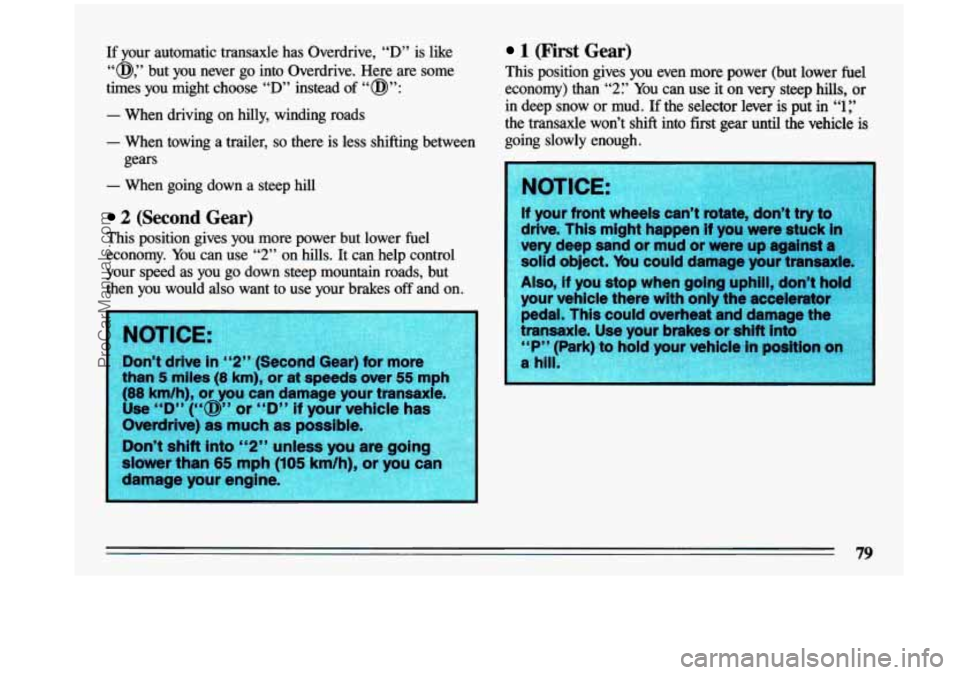
If your automatic transaxle has Overdrive, “D” is like
“a,” but you never go into Overdrive. Here are some
times you might choose
“D” instead of “@”:
- When driving on hilly, winding roads
- When towing a trailer, so there is less shifting between
gears
- When going down a steep hill
2 (Second Gear)
This position gives you more power but lower fuel
economy. You can use
“2” on hills. It can help control
your speed as you go down steep mountain roads, but
then you would also want to use your brakes off and on.
1 (First Gear)
This position gives you even more power (but lower fuel
economy) than 2. You can use it on very steep hills, or
in deep snow or mud. If the selector lever is put in “1 i’
the transaxle won’t shift into first gear until the vehicle is
going slowly enough.
bb 99
79
ProCarManuals.com
Page 82 of 324
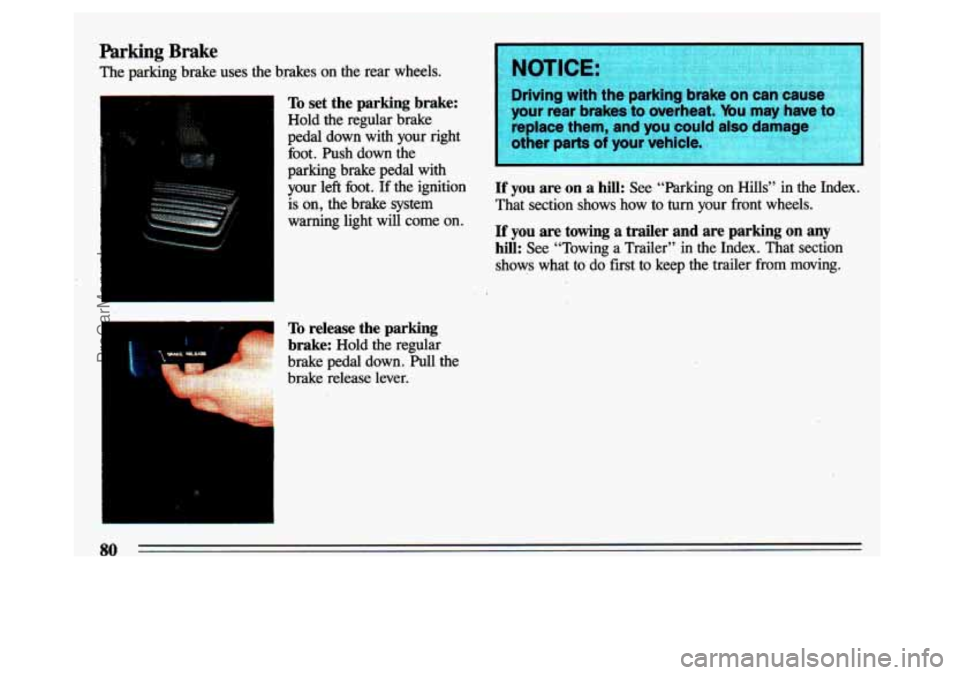
Parking Brake
The parking brake uses the brakes on the rear wheels.
I
To set the parking brake:
Hold the regular brake
pedal down with your right
foot. Push down the
parking brake pedal with
your left foot.
If the ignition
is on, the brake system
I warning light will come on.
L
I
To release the parking
brake:
Hold the regular
brake pedal down. Pull the
brake release lever.
NOTICE:
Driving with thiparl ‘g brake or )use
your rear brakesto oveFheat. ybu may have
-
replace them, and you could alse damage
other parts
of your vehicle.
If you are on a hill: See “Parking on Hills” in the Index.
That section shows
how to turn your front wheels.
If you are towing a trailer and are parking on any
hill: See “Towing a Trailer” in the Index. That section
shows what to do first to keep the trailer from
moving.
80
ProCarManuals.com
Page 83 of 324
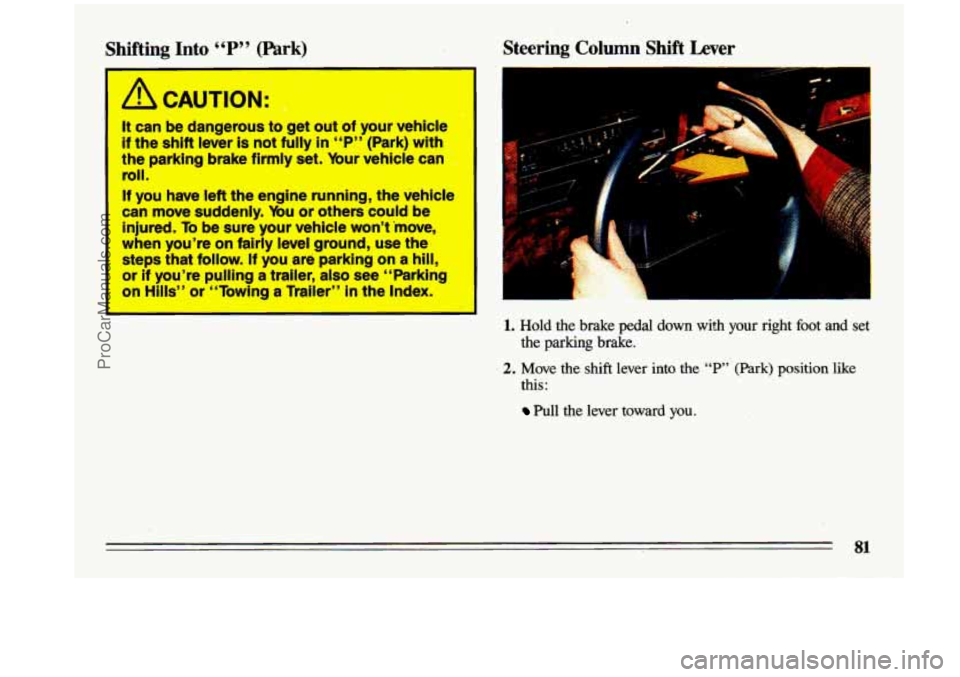
Shifting Into “P” (Park)
,3
/i CAUTION: ~
It can be dangerous to get out of your vehlcle
if the shift lever is not fully in “P” (Park) with ,
the parking brake firmly set. bur vehicle can -.
roll.
If you have left the engine runnin.g, the vehicle
can move suddenly. ybu
or others could be
injured. To be sure your vehicle won’t inwe,
when you’re on fairly level ground, Use the ‘
steps that follow. If you are parking on a hill,
or if you’m pulling a trailer, also see. “Parking
on Hills” or “Towing B Trailer” in the Index.
Steering Column Shift Lever
1. Hold the brake pedal down with your right foot and set
the parking brake.
2. Move the shift lever into the “P” (Park) position like
this:
Pull the lever toward you.
81
ProCarManuals.com